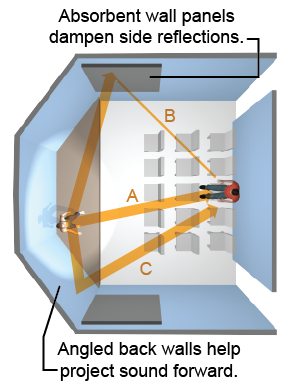|
Virtually every sound you hear is affected by interference and resonance. In this context, the term interference does not mean anything bad. Interference just means that more than one frequency is present in the sound and that the overall wave form is the sum of multiple frequencies. Resonance in sound maximizes certain frequencies and eliminates or weakens others. Resonance occurs when you blow air across the top of a bottle, strike a tuning fork, or run a bow across a violin string. The distinctive frequency balance that makes a person’s voice unique and recognizable comes from complex resonances involving your vocal cords, larynx, mouth, tongue, and even your nasal passages! 
|
Echoes and reverberation
|
If you yell “hello!” 170 m away from a large wall, the sound will reflect back to you one second later as a distinct echo. An echo is a reflected sound wave. One second is the round-trip time for the sound wave traveling at 340 m/s. But what will happen when the wall is much closer, say 10 m away? The round-trip echo time is 0.06 s. What will you hear? 
|

|
In a good concert hall you hear music directly from the stage but you also hear a multiple echo called reverberation. Reverberation is the addition of multiple reflections of a sound to the original sound. Each reflection is slightly delayed but not so much that the echo is distinctly recognizable. Reverberation adds liveliness, depth, and richness to sound and concert halls are specifically designed to created the right amount of “reverb.” Many musicians use reverb effects that electronically add layers of echoes to their sound. 
|
 Think about sitting in the middle of an auditorium. You hear sound directly along path A but also reflected sound (along path B, C, and others). The shape of the room and the wall surfaces are designed so that there is enough reverberation to be pleasant but not too much, which would “muddy” the sound. Furthermore, a good design avoids creating locations where indirect, reflected sounds interfere destructively with direct sound waves; in those “dead spots,” certain frequency ranges will lose clarity or volume. Many auditoriums have movable ceiling panels (“clouds”) that can be rearranged to balance the reverberation for different performances and instruments.
Think about sitting in the middle of an auditorium. You hear sound directly along path A but also reflected sound (along path B, C, and others). The shape of the room and the wall surfaces are designed so that there is enough reverberation to be pleasant but not too much, which would “muddy” the sound. Furthermore, a good design avoids creating locations where indirect, reflected sounds interfere destructively with direct sound waves; in those “dead spots,” certain frequency ranges will lose clarity or volume. Many auditoriums have movable ceiling panels (“clouds”) that can be rearranged to balance the reverberation for different performances and instruments. 
|
| |
|

